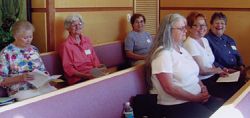Benedictine Oblates seek God daily

OGDEN — The oblates of Mount Benedict Monastery are Christian men and women who associate themselves formally with the Benedictine community while continuing to live as lay people. "Becoming an oblate is a way to strengthen their baptismal commitment and enrich their Christian way of life," said Benedictine Sister Luke Hoschette, a member of the Oblate team. The oblates of Mount Benedict Monastery include two groups, one in Moab and one in Ogden that includes people from the Salt Lake Valley. "Oblates promise to share the Benedictine way of life and monastic values in their own state in life," said Sr. Luke. "They become Benedictine oblates to seek God daily through study, prayer and works of social justice as a member of the Catholic Church. We encourage them to practice Lectio Divina and pray daily the Divine Office for lay people. I think they can get a certain amount of spiritual strength and inspiration from living the Benedictine way of life. Oblates follow the Rule of St. Benedict even though it was written in the 5th century. "It is interpreted using St. Benedict’s philosophy so that its members have the sense of hospitality and charity toward all, to welcome the stranger and take care of the sick as if they were Christ," said Sr. Luke. "It allows everyone time for prayer and work; one is not more important than the other." "The 1,500 year-old Rule is amendable to modern living," said Father Rick Sherman, pastor of Saint Elizabeth Parish, Saint Jude Mission, San Juan Diego Mission and the prison in Gunnison. He established the group in Moab while he was pastor of Saint Pius X. He had been a priest for six years when he became an oblate. "To actually change our lifestyles and world views in a real sustainable way needs a deep spirituality and a sense of radical, transcended purpose," he said. "One of our greatest challenges of ministering in modern America is figuring out how to help people find the time and sacred space in their lives to nourish their souls." Before becoming a priest, Fr. Sherman thought about becoming a monk, he said. He was exposed to Benedictine spirituality while attending Mount Angel Seminary and learned to appreciate it. Fr. Sherman invited the Benedictine sisters to give a presentation on oblates and the Benedictine Rule. St. Pius X parishioners Bernie Franta and his wife were interested because it expanded their spirituality. "We went through a year of inquiry and a series of 10 classes to became oblates," said Franta. "The sisters come down twice a year for meetings, and we attend the annual retreat in Ogden." "Oblates are not just Catholic, they come from various denominations," said Joanne Sullivan, a member of Holy Family Parish, Ogden. Sullivan is on the oblate team in Ogden and meets with candidates for classes on applying the Rule to one’s daily life. "Attending the bimonthly meetings is like an oasis," said Karen Sagehorn, a member of Saint Thomas More Parish, Sandy. Sagehorn has been an oblate for two years and said it is peaceful to meet with and to study, meditate and pray with the other oblates. Sagehorn runs a day care in her home from 6 a.m. to 6 p.m. and incorporates the Rule as she works. "I keep God at the center of my life and apply the Rule through hospitality, graciousness, welcoming people and seeing Christ in the people I meet," she said. "We cannot reflect mindfully and morally about our modern complicated lives while we are running from one event to another," said Fr. Sherman. "Truly mindful reflection requires a certain kind of time and space and a certain moral structure out of which to think, and Benedictine spirituality allows that."
© Copyright 2025 The Diocese of Salt Lake City. All rights reserved.

Stay Connected With Us